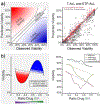Development of constitutively synergistic nanoformulations to enhance chemosensitivity in T-cell leukemia
- PMID: 37543290
- PMCID: PMC10544718
- DOI: 10.1016/j.jconrel.2023.07.045
Development of constitutively synergistic nanoformulations to enhance chemosensitivity in T-cell leukemia
Abstract
Advances in multiagent chemotherapy have led to recent improvements in survival for patients with acute lymphoblastic leukemia (ALL); however, a significant fraction do not respond to frontline chemotherapy or later relapse with recurrent disease, after which long-term survival rates remain low. To develop new, effective treatment options for these patients, we conducted a series of high-throughput combination drug screens to identify chemotherapies that synergize in a lineage-specific manner with MRX-2843, a small molecule dual MERTK and FLT3 kinase inhibitor currently in clinical testing for treatment of relapsed/refractory leukemias and solid tumors. Using experimental and computational approaches, we found that MRX-2843 synergized strongly-and in a ratio-dependent manner-with vincristine to inhibit both B-ALL and T-ALL cell line expansion. Based on these findings, we developed multiagent lipid nanoparticle formulations of these drugs that not only delivered defined drug ratios intracellularly in T-ALL, but also improved anti-leukemia activity following drug encapsulation. Synergistic and additive interactions were recapitulated in primary T-ALL patient samples treated with MRX-2843 and vincristine nanoparticle formulations, suggesting their clinical relevance. Moreover, the nanoparticle formulations reduced disease burden and prolonged survival in an orthotopic murine xenograft model of early thymic precursor T-ALL (ETP-ALL), with both agents contributing to therapeutic activity in a dose-dependent manner. In contrast, nanoparticles containing MRX-2843 alone were ineffective in this model. Thus, MRX-2843 increased the sensitivity of ETP-ALL cells to vincristine in vivo. In this context, the additive particles, containing a higher dose of MRX-2843, provided more effective disease control than the synergistic particles. In contrast, particles containing an even higher, antagonistic ratio of MRX-2843 and vincristine were less effective. Thus, both the drug dose and the ratio-dependent interaction between MRX-2843 and vincristine significantly impacted therapeutic activity in vivo. Together, these findings present a systematic approach to high-throughput combination drug screening and multiagent drug delivery that maximizes the therapeutic potential of combined MRX-2843 and vincristine in T-ALL and describe a novel translational agent that could be used to enhance therapeutic responses to vincristine in patients with T-ALL. This broadly generalizable approach could also be applied to develop other constitutively synergistic combination products for the treatment of cancer and other diseases.
Keywords: Combination therapy; Drug delivery; Drug screening; Lipid nanoparticle; Nanotechnology; Synergy.
Copyright © 2023 Elsevier B.V. All rights reserved.
Conflict of interest statement
Declaration of Competing Interest D.K.G. is a founder and serves on the Board of Directors of Meryx, Inc. X.W., D.K.G., and D.D. are equity holders in Meryx, Inc. X.W. is inventor on a patent for MRX-2843. J.M.K., J.J., D.K.G., D.D., and E.C.D. are inventors on a patent related to this work describing combination drug screening, formulation, and treatment.
Figures





References
-
- Frei III E, Karon M, Levin RH, Freireich EJ, Taylor RJ, Hananian J, Selawry O, Holland JF, Hoogstraten B, Wolman IJ, The effectiveness of combinations of antileukemic agents in inducing and maintaining remission in children with acute leukemia, Blood, 26 (1965) 642–656. - PubMed
-
- Moxley JH, De Vita VT, Brace K, Frei E, Intensive Combination Chemotherapy and X-irradiation in Hodgkin’s Disease, Cancer Res, 27 (1967) 1258–1263. - PubMed
-
- Devita V, Serpick A, Carbone P, Combination Chemotherapy in the Treatment of Advanced Hodgkin’s Disease, Ann. Intern. Med, 73 (1970) 881–895. - PubMed
-
- Bayne WF, Mayer LD, Swenson CE, Pharmacokinetics of CPX-351 (cytarabine/daunorubicin HCl) liposome injection in the mouse, Journal of pharmaceutical sciences, 98 (2009) 2540–2548. - PubMed
Publication types
MeSH terms
Substances
Grants and funding
LinkOut - more resources
Full Text Sources
Miscellaneous

